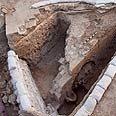
Aqueduct bridge
צילום: אסף פרץ, באדיבות רשות העתיקות
2,000 years of water in Jerusalem
Spectacular arched bridge that was part of ancient aqueduct which conveyed water to Temple Mount exposed recently in archaeological excavations near the Sultan’s Pool
A spectacular arched bridge that was part of the ancient aqueduct which conveyed water to the Temple Mount was exposed recently in archaeological excavations the Israel Antiquities Authority conducted near the Sultan’s Pool, in the “Walls around Jerusalem National Park”, prior to infrastructure work by the Gihon Corporation
Work on the city’s modern water infrastructure uncovered a section of Jerusalem’s ancient aqueduct. While the Gihon Corporation was working on the sewage infrastructure in the vicinity of the Sultan’s Pool in the “Walls around Jerusalem National Park”, a section of Jerusalem’s ancient aqueduct was discovered. In the wake of this discovery, the Israel Antiquities Authority conducted an excavation in which a spectacular arched bridge was revealed that was part of the very old aqueduct that conveyed water to the Temple Mount.
IAA worker near aqueduct bridge (Photo: Assaf Peretz, courtesy of Israel Antiquities Authority)
According to Yehiel Zelinger, excavation director on behalf of the Israel Antiquities Authority, “The bridge, which could still be seen at the end of the nineteenth century and appears in old photographs, was covered over during the twentieth century. We were thrilled when it suddenly reappeared in all its grandeur during the course of the archaeological excavations”.
Zelinger said, “The route of the Low Level aqueduct from the time of the Second Temple, beginning at Solomon’s Pools near Bethlehem and ending at the Temple Mount, is well known to scholars: substantial parts of it were documented along the edge of Yemin Moshe neighborhood and on the slope adjacent to the western wall of the Old City.
"The upper part of Gai Ben-Hinnom passes between the two sections of aqueduct where the Sultan’s Pool was built as a reservoir for flood water. In order to maintain the elevation of the path along which the water flowed, a bridge was erected above the ravine. Two of the original nine arches that were in the bridge were currently excavated to their full height of about 3 meters”.
“The bridge was built in 1320 CE (in the Mamluk period) by the sultan Nasser al-Din Muhammed Ibn Qalawun, as evidenced by the dedicatory inscription set in it; however, it was apparently constructed to replace an earlier bridge dating to the time of the Second Temple period that was part of the original aqueduct”.
The Israel Antiquities Authority, in cooperation with the Nature and Parks Authority, is working to expose the entire length of the arched bridge, conserve it and integrate it in the framework of the overall development of the Sultan’s Pool, as part of underscoring the importance of the water supply to Jerusalem in ancient times.
The Gihon Corporation, whose name preserves that of Jerusalem’s ancient source of water, is assisting in funding excavations that uncover Jerusalem’s ancient water systems of.











